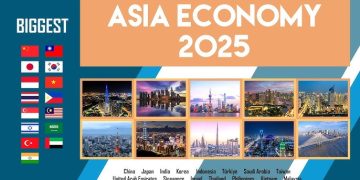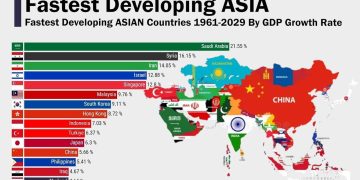I. Introduction: The End of Cost-First Globalization
For nearly four decades, global supply chains were governed by a simple principle:
produce where it is cheapest and sell where demand is highest.
Corporations optimized for efficiency, low labor costs, minimal inventory, and just-in-time logistics. Governments encouraged globalization; capital flowed freely; and multinational production systems expanded across borders without major geopolitical constraints.
That era is over.
COVID-19 exposed vulnerabilities in highly concentrated supply networks. The U.S.–China strategic rivalry raised concerns about economic and technological dependence. Climate shocks, energy disruptions, and geopolitical confrontations further destabilized supply flows.
Today’s supply chains are being reconfigured around resilience, security, diversification, and regionalization. Efficiency still matters, but it is no longer the dominant logic. This shift carries profound implications for global finance, investment patterns, and the geography of economic power.
This article examines:
- Why supply chains are restructuring
- How capital allocation is shifting
- Which regions are emerging as winners
- The new role of governments and industrial policy
- The financial consequences of a multi-regional production system
- What the next decade of global manufacturing will look like
II. Structural Drivers Reshaping Global Supply Chains
1. Geopolitics: The Dominant Force
Geopolitics is no longer a background variable—it is the primary driver of supply chain change.
Key developments include:
- U.S.–China decoupling in tech and manufacturing
- Sanctions and export controls on chips, AI, quantum tech, and dual-use goods
- Strategic competition over semiconductor dominance
- Concerns about energy and food weaponization
- Realignment of trade partnerships
Supply chain decisions are now political decisions. Corporations increasingly choose locations based not only on labor costs but also:
- geopolitical alignment
- regulatory compatibility
- access to domestic subsidies
- resilience against sanctions or disruptions
2. Technological Shifts: Automation, Digitalization, and Smart Manufacturing
Rising labor costs in China and technological advancements globally are reducing the wage arbitrage advantage. Automation, robotics, and AI-driven optimization reshape manufacturing economics:
- smart factories reduce reliance on low-cost labor
- production becomes more modular and scalable
- digital twins optimize logistics and inventory
- cloud-based manufacturing platforms enable remote coordination
This enables companies to relocate production closer to major markets without dramatically increasing costs.
3. Sustainability and Climate Transition
Climate policy is driving reconfiguration in three ways:
- electrification of transport and manufacturing
- demand for renewable energy and low-carbon production
- pressure to reduce Scope 3 emissions through diversified and transparent supply networks
Europe is the most aggressive in linking climate policy to supply chain rules (e.g., Carbon Border Adjustment Mechanism).
4. Corporate Risk Management and the Shift from “Just-in-Time” to “Just-in-Case”
Enterprises now adopt risk-based frameworks:
- multiple supplier networks
- expanded inventory buffers
- regional manufacturing hubs
- diversified logistics routes
- resilience stress testing
This increases operational costs but reduces systemic vulnerability.
III. The New Geography of Global Supply Chains
1. China: Still the Core, but Transforming
Despite geopolitical tensions, China retains unmatched manufacturing capability:
- unparalleled supplier ecosystems
- advanced logistics networks
- scale, speed, and engineering talent
- leadership in batteries, EVs, solar, and consumer electronics
However, its role is shifting from “world factory” to:
- high-tech manufacturing hub
- domestic consumption engine
- regional anchor for Asian supply chains
- exporter of industrial capacity through Belt and Road
China is not losing its dominance—it is transforming its position in global production.
2. United States: The Rise of Strategic Manufacturing
Driven by national security concerns, the U.S. is reindustrializing:
- semiconductor fabs (Intel, TSMC, Samsung)
- battery and EV supply chains
- biotechnology and pharmaceutical reshoring
- defense manufacturing expansion
The CHIPS and Science Act and the Inflation Reduction Act (IRA) provide unprecedented subsidies, attracting both domestic and foreign capital.
3. Southeast Asia: The Prime Beneficiary of Diversification
Countries such as Vietnam, Indonesia, Thailand, and Malaysia benefit from “China + 1” strategies. Key sectors include:
- electronics assembly
- smartphones and consumer devices
- textiles and footwear
- automotive parts
- data centers and cloud infrastructure
Vietnam in particular has become a top destination for tech manufacturing, with major investments from Apple’s suppliers, Samsung, and Foxconn.
4. India: Rising as a Manufacturing and Investment Magnet
India’s advantages:
- massive labor force
- improving infrastructure
- geopolitical neutrality
- strong domestic market
- government incentives for electronics, semiconductors, and renewables
Apple’s production shift to India is one of the most significant supply chain trends of the decade.
5. Mexico: North America’s Nearshoring Champion
Under USMCA and geopolitical realignment, Mexico is experiencing:
- reshoring of U.S. manufacturing
- growth in automotive and EV supply chains
- boom in industrial real estate
- investments in electronics and machinery
Mexico’s proximity to the U.S. makes it central to North America’s regional production system.
6. Europe: Rebuilding Industrial Capabilities
Europe faces high energy costs but compensates through:
- highly skilled workforce
- strong environmental regulations
- aggressive green subsidies
- strategic focus on batteries, hydrogen, and clean tech
- tightening supply chain standards
Germany, France, and Eastern Europe are important nodes.
7. Middle East: The Emergence of Industrial Ambition
Saudi Arabia and UAE aim to diversify away from oil:
- large-scale investments in logistics, ports, and free zones
- partnerships with Asian and Western manufacturers
- sovereign wealth funds financing industrial expansion
The region is positioning itself as a global logistics and advanced manufacturing hub.
IV. Financial Implications of Supply Chain Reconfiguration
1. Rising Capital Expenditures (CapEx)
Companies must invest heavily in:
- new regional factories
- diversified sourcing networks
- automation and robotics
- logistics and warehousing capacity
Global CapEx cycles are shifting from software and digital platforms to physical infrastructure.
2. Higher Operating Costs and Inflationary Pressure
Resilient supply chains cost more:
- diversified suppliers increase procurement costs
- nearshoring often leads to higher labor expenses
- compliance with climate rules raises production costs
This contributes to structural inflation, pushing central banks to maintain higher interest rates.
3. Government Subsidies as Primary Capital Catalysts
Industrial policy reshapes financial incentives:
- U.S. IRA and CHIPS
- EU’s Green Deal subsidies
- China’s support for strategic technologies
- India’s PLI schemes
- Middle East sovereign funds funding manufacturing capacity
Public capital crowds in private investment.
4. Increased Reliance on Regional Financial Systems
The rise of regionalization strengthens regional financing:
- Asian Development Bank (ADB) for Southeast Asia
- European Investment Bank (EIB) for EU projects
- Gulf sovereign wealth funds for Middle East industrialization
- U.S. government financing through EXIM and DFC
Cross-border financial integration becomes more bloc-based.
5. New Asset Classes and Investment Opportunities
Investors benefit from:
- industrial real estate
- automation and robotics firms
- semiconductor and battery supply chains
- logistics and shipping companies
- green energy infrastructure
- critical minerals mining
Fragmentation creates winners and losers—investors must understand the new map.
V. Case Studies: What Reconfigured Supply Chains Look Like
1. The Semiconductor Sector
Semiconductors illustrate the most dramatic supply chain transformation:
- TSMC, Samsung, and Intel expand into the U.S., Japan, and Europe
- China accelerates self-sufficiency through massive investment
- the U.S. prioritizes advanced nodes; others focus on mature nodes
- supply chains split into parallel ecosystems
Chip production is now a geopolitical asset—not just an economic activity.
2. Electric Vehicles and Battery Ecosystems
The EV supply chain shifts to diversify away from China:
- U.S. builds IRA-compliant lithium battery plants
- Europe adopts strict battery content regulations
- Southeast Asia expands nickel refining and cathode production
- China remains dominant in materials processing
The result is a multi-regional supply ecosystem with China still essential.
3. Pharmaceuticals and Biotech
COVID-19 exposed vulnerabilities:
- the U.S. and EU invest in domestic vaccine and drug production
- India expands its pharmaceutical export capacity
- China moves up the value chain in biotech
Regulators now emphasize supply chain transparency and local capacity.
VI. Future Scenarios: What Will Supply Chains Look Like by 2035?
Scenario 1: Multipolar Regionalization (Most Likely)
- three major production blocs: North America, Europe, and Asia
- China remains central but with reduced dominance
- India and Southeast Asia grow rapidly
- geopolitical tensions persist but remain manageable
Scenario 2: Parallel Tech and Manufacturing Ecosystems
U.S. and China form separate systems:
- distinct chip standards
- separate digital infrastructure
- duplicated renewable energy supply chains
- incompatible data and cloud regulations
Global companies must choose sides.
Scenario 3: Re-globalization Through Technology
AI-driven optimization reduces geopolitical pressure:
- ultra-efficient supply chain simulations
- autonomous shipping and logistics
- automated factories minimize labor concerns
- global carbon pricing creates unified standards
Cooperation gradually returns.
VII. Strategic Implications
For Governments:
- Build national resilience in critical sectors
- Strengthen regional trade and investment frameworks
- Develop domestic manufacturing talent and automation capacity
- Use industrial policy to attract strategic industries
For Corporations:
- Invest in supply chain risk modeling
- Build modular and regional production footprints
- Maintain dual sourcing strategies
- Increase investment in digitalization and predictive logistics
For Investors:
- Focus on CapEx-heavy sectors poised for long-term growth
- Diversify across geographies aligned with nearshoring
- Increase exposure to industrial automation, robotics, and logistics
- Track climate-policy-induced shifts in production economics
VIII. Conclusion: A New Era of Distributed Manufacturing
The world is moving from a model of centralized efficiency to one of distributed resilience.
Global supply chains are not collapsing—they are being rebalanced, re-anchored, and regionally diversified.
This shift will define the next decade of global growth, innovation, and investment. Those who understand the new logic of production will gain a strategic advantage in a world where manufacturing, logistics, capital, and geopolitics are more interconnected than ever.

































